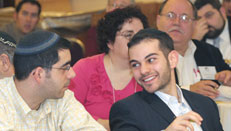 |
||||||||||||
| Weekly Parsha | ||
| Current Week | ||
| Parsha Archives | ||
| Business Ethics | ||
| Dr. Malamet Speaks Out | ||
| TiM MP3 Library | ||




A Thought for the Week with Rabbi Jay Kelman
|
 The holiday of Simchat Torah is of post-Talmudic (not to mention post-Biblical) origin. The cyclical reading of the Torah was instituted initially by Moshe Rabbeinu himself. In his capacity as the leading rabbinical sage of the time, Moshe issued a rabbinical decree that one must read from the Torah on the mornings of Shabbat, Monday, and Thursday lest three days pass without public reading of the Torah; three days was considered the longest one could survive without physical and/or spiritual sustenance. Ezra (sixth century BCE), who was responsible for guiding the Jews during the aftermath of the Babylonian exile, added the reading for Shabbat afternoon and decided on many of the actual details of our public reading of the Torah. The Torah was originally divided into a tri-annual cycle of readings, and was read both in the original Hebrew and as a verse-by-verse translation in Aramaic (the spoken language of the day). This custom of Aramaic reading persisted in some communities as late as the thirteenth century. It appears that during the Geonic period (7th-11th centuries), our present custom of an annual cycle of Torah reading culminating in Simchat Torah became well established. What we must understand is why the rabbis chose the holiday of Sukkoth, or more specifically, Shmini Atzeret (as the eighth day of Sukkoth is called in the Torah), to conclude and restart the reading of the Torah. Would not Shavuot, the anniversary of our receiving the Torah, have been more appropriate? Historically, while we received the Torah on Shavuot, that Torah was short-lived. Our covenantal relationship with G-d was in doubt in the aftermath of the sin of the golden calf. The Torah we have today was received on Yom Kippur, which our Sages have thus declared to be the happiest day of the year. "The orders of Hashem are upright, gladdening the heart" (Psalms 19:9). The study and implementation of Torah brings us much joy. Thus, a mourner is forbidden to study Torah. Sukkoth, the festival known as z'man simchateinu, the time of our joy, is thus the perfect time to celebrate our receiving of the Torah. On Sukkoth the four species, which remind us of the blessings of the harvest and the Sukkah which remind us of our dependence on G-d, help bring us great joy. But Shmini Atzeret has no rituals to prompt us in the service of G-d. It is natural joy, the joy of a newly married couple who rejoice in each other. It is the pure joy of Torah. Agriculturally, the Sukkoth season marks the end of the harvest and the beginning of the new planting season (in Israel , anyway). Linking the spiritual and the physical worlds, we reap the fruit of a year of Torah study and begin studying our precious Torah once again. The conclusion of Sukkoth brings with it slight feelings of melancholy. The festival season, which began on Pesach, is over. The days are rapidly getting shorter as we prepare for the long cold winter ahead. It was just this reason that our Sages cite for the holiday of Shmini Atzeret, which has no real historical or agricultural significance. "Let's just spend another day together", G-d declares before the long winter season. As we study the Torah, we realize that we must harness nature to make this world a better place in both a physical and spiritual sense. Much of nature may be dormant, but it is getting ready to regenerate. In the meantime, let us focus our energies in regenerating ourselves in the study of Torah. May we merit rejoicing in the study of Torah. |
|
|

 |
 |